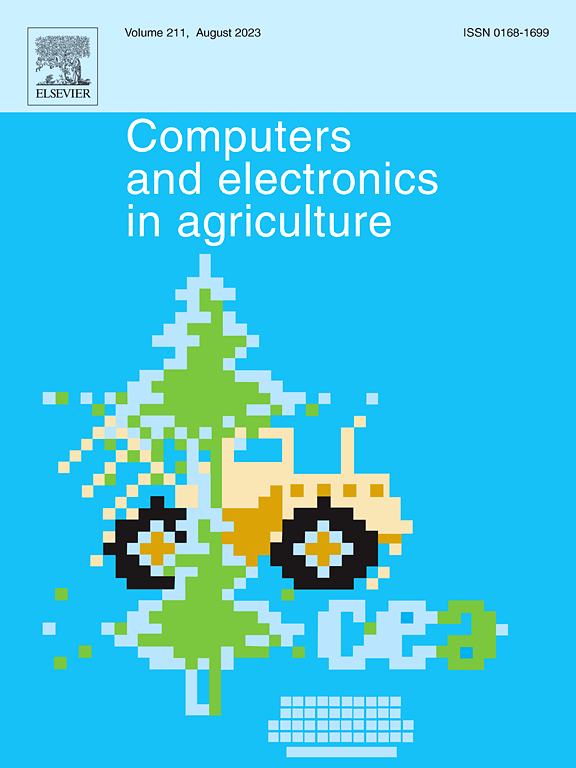UAV-based path planning for efficient localization of non-uniformly distributed weeds using prior knowledge: A reinforcement-learning approach
IF 8.9
1区 农林科学
Q1 AGRICULTURE, MULTIDISCIPLINARY
引用次数: 0
Abstract
UAVs are becoming popular in agriculture, however, they usually use time-consuming row-by-row flight paths. This paper presents a deep-reinforcement-learning-based approach for path planning to efficiently localize weeds in agricultural fields using UAVs with minimal flight-path length. The method combines prior knowledge about the field containing uncertain, low-resolution weed locations with in-flight weed detections. The search policy was learned using deep Q-learning. We trained the agent in simulation, allowing a thorough evaluation of the weed distribution, typical errors in the perception system, prior knowledge, and different stopping criteria on the planner’s performance. When weeds were non-uniformly distributed over the field, the agent found them faster than a row-by-row path, showing its capability to learn and exploit the weed distribution. Detection errors and prior knowledge quality had a minor effect on the performance, indicating that the learned search policy was robust to detection errors and did not need detailed prior knowledge. The agent also learned to terminate the search. To test the transferability of the learned policy to a real-world scenario, the planner was tested on real-world image data without further training, which showed a 66% shorter path compared to a row-by-row path at the cost of a 10% lower percentage of found weeds. Strengths and weaknesses of the planner for practical application are comprehensively discussed, and directions for further development are provided. Overall, it is concluded that the learned search policy can improve the efficiency of finding non-uniformly distributed weeds using a UAV and shows potential for use in agricultural practice.
基于无人机的路径规划,利用先验知识有效定位非均匀分布杂草:一种强化学习方法
无人机在农业中越来越受欢迎,然而,它们通常使用耗时的逐排飞行路径。本文提出了一种基于深度强化学习的路径规划方法,利用最小飞行路径长度的无人机对农田杂草进行有效定位。该方法将包含不确定、低分辨率杂草位置的先验知识与飞行中的杂草检测相结合。使用深度Q-learning学习搜索策略。我们在模拟中训练智能体,允许对杂草分布、感知系统中的典型错误、先验知识和对计划器性能的不同停止标准进行全面评估。当杂草在田间不均匀分布时,智能体比逐行路径更快地找到它们,显示出它学习和利用杂草分布的能力。检测误差和先验知识质量对性能的影响较小,表明学习搜索策略对检测误差具有鲁棒性,不需要详细的先验知识。代理也学会了终止搜索。为了测试学习到的策略在真实场景中的可移植性,在没有进一步训练的情况下,对规划器进行了真实图像数据测试,结果显示,与逐行路径相比,路径缩短了66%,而发现杂草的比例降低了10%。全面讨论了该规划器在实际应用中的优缺点,并提出了进一步发展的方向。综上所述,该学习搜索策略可以提高无人机查找非均匀分布杂草的效率,在农业实践中具有应用潜力。
本文章由计算机程序翻译,如有差异,请以英文原文为准。
求助全文
约1分钟内获得全文
求助全文
来源期刊

Computers and Electronics in Agriculture
工程技术-计算机:跨学科应用
CiteScore
15.30
自引率
14.50%
发文量
800
审稿时长
62 days
期刊介绍:
Computers and Electronics in Agriculture provides international coverage of advancements in computer hardware, software, electronic instrumentation, and control systems applied to agricultural challenges. Encompassing agronomy, horticulture, forestry, aquaculture, and animal farming, the journal publishes original papers, reviews, and applications notes. It explores the use of computers and electronics in plant or animal agricultural production, covering topics like agricultural soils, water, pests, controlled environments, and waste. The scope extends to on-farm post-harvest operations and relevant technologies, including artificial intelligence, sensors, machine vision, robotics, networking, and simulation modeling. Its companion journal, Smart Agricultural Technology, continues the focus on smart applications in production agriculture.
 求助内容:
求助内容: 应助结果提醒方式:
应助结果提醒方式:


